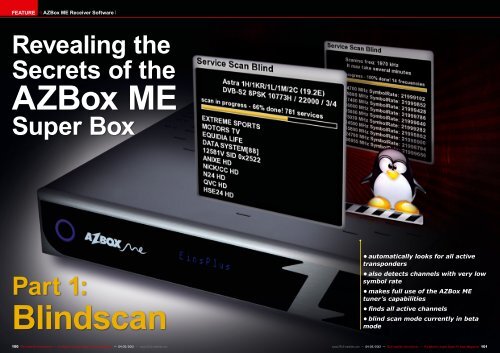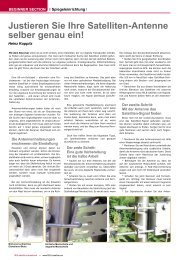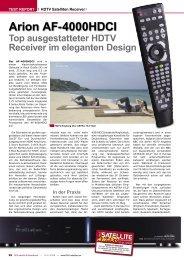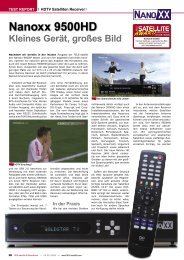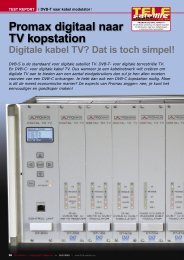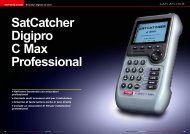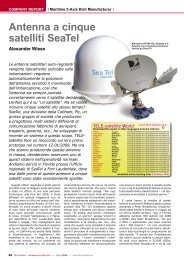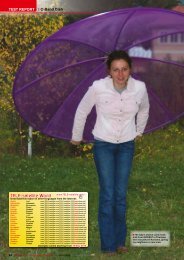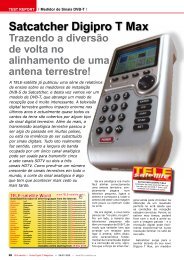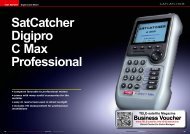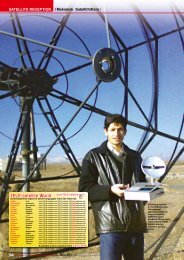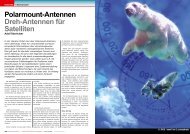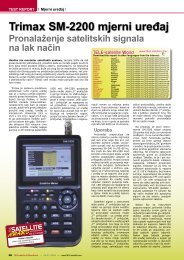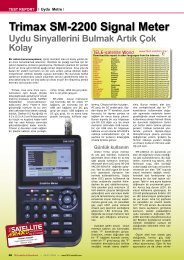Revealing the Secrets of the Super Box Part 1: - TELE-satellite ...
Revealing the Secrets of the Super Box Part 1: - TELE-satellite ...
Revealing the Secrets of the Super Box Part 1: - TELE-satellite ...
You also want an ePaper? Increase the reach of your titles
YUMPU automatically turns print PDFs into web optimized ePapers that Google loves.
FEATURE AZ<strong>Box</strong> ME Receiver S<strong>of</strong>tware<br />
<strong>Revealing</strong> <strong>the</strong><br />
<strong>Secrets</strong> <strong>of</strong> <strong>the</strong><br />
AZ<strong>Box</strong> ME<br />
<strong>Super</strong> <strong>Box</strong><br />
<strong>Part</strong> 1:<br />
Blindscan<br />
• automatically looks for all active<br />
transponders<br />
• also detects channels with very low<br />
symbol rate<br />
• makes full use <strong>of</strong> <strong>the</strong> AZ<strong>Box</strong> ME<br />
tuner’s capabilities<br />
• finds all active channels<br />
• blind scan mode currently in beta<br />
mode<br />
100 <strong>TELE</strong>-<strong>satellite</strong> International — The World‘s Largest Digital TV Trade Magazine — 04-05/2012 — www.<strong>TELE</strong>-<strong>satellite</strong>.com www.<strong>TELE</strong>-<strong>satellite</strong>.com — 04-05/2012 — <strong>TELE</strong>-<strong>satellite</strong> International — The World‘s Largest Digital TV Trade Magazine 101
FEATURE<br />
Blindscan<br />
for <strong>the</strong> AZ<strong>Box</strong> ME<br />
Vitor Martins Augusto<br />
In <strong>TELE</strong>-<strong>satellite</strong> 02-03/2012<br />
we introduced <strong>the</strong> new Opensat<br />
super box by <strong>the</strong> name<br />
<strong>of</strong> AZ<strong>Box</strong> ME. At <strong>the</strong> time<br />
we were not able to test <strong>the</strong><br />
blind scan function, as it was<br />
not yet implemented. Opensat<br />
has meanwhile released a<br />
new version <strong>of</strong> <strong>the</strong> receiver’s<br />
firmware which features a<br />
beta version <strong>of</strong> <strong>the</strong> blind scan<br />
mode. The updated s<strong>of</strong>tware<br />
was launched much quicker<br />
than we expected and thus<br />
proves once again Opensat’s<br />
commitment and customer<br />
dedication. It is <strong>the</strong> feed hunters<br />
among us who will appreciate<br />
more than anybody else<br />
that Opensat always keeps its<br />
1<br />
AZ<strong>Box</strong> ME Receiver S<strong>of</strong>tware<br />
promises and does not leave<br />
us in <strong>the</strong> dark as far as new<br />
features are concerned.<br />
Naturally, we turned on our<br />
AZ<strong>Box</strong> ME right away to have<br />
an in-depth look at how Opensat<br />
delivers blind scan functionality.<br />
The new firmware<br />
image needs to be flashed before<br />
<strong>the</strong> amended s<strong>of</strong>tware is<br />
available. Since <strong>the</strong> AZ<strong>Box</strong> ME<br />
comes with a large flash chip<br />
that allows parallel installation<br />
<strong>of</strong> up to three different firmware<br />
versions, we decided to<br />
install <strong>the</strong> new v1.6 firmware<br />
in memory bank no. 2.<br />
For <strong>the</strong> sceptics among you<br />
we are happy to reveal that<br />
<strong>the</strong> flash procedure does not<br />
require a degree in engineering:<br />
You simply reboot <strong>the</strong> receiver<br />
and as soon as <strong>the</strong> boot<br />
menu is displayed on <strong>the</strong> VFD<br />
display you press <strong>the</strong> VOL+<br />
button to get <strong>the</strong> boot loader<br />
into flash mode. Next, <strong>the</strong> receiver’s<br />
IP address appears<br />
on <strong>the</strong> VFD display and has to<br />
be entered in a web browser.<br />
We used Mozilla Firefox, which<br />
works best with <strong>the</strong> web functions<br />
<strong>of</strong> <strong>the</strong> recceiver. If you<br />
prefer Chrome or <strong>the</strong> Internet<br />
explorer, <strong>the</strong>y can be used<br />
just as well in this case.<br />
The web browser <strong>the</strong>n displays<br />
a website that is generated<br />
by <strong>the</strong> receiver. Here,<br />
you first have to decide which<br />
102 <strong>TELE</strong>-<strong>satellite</strong> International — The World‘s Largest Digital TV Trade Magazine — 04-05/2012 — www.<strong>TELE</strong>-<strong>satellite</strong>.com<br />
<strong>of</strong> <strong>the</strong> three available memory<br />
banks you want to use for <strong>the</strong><br />
new firmware. In addition,<br />
you may access <strong>the</strong> ‘MICOM<br />
Upgrade’ menu to update <strong>the</strong><br />
front processor as well. Please<br />
bear in mind, though, that this<br />
should only be done when absolutely<br />
necessary. Never use<br />
a wrong file out <strong>of</strong> <strong>the</strong> blue, as<br />
this may result in <strong>the</strong> remote<br />
control not working any longer<br />
and <strong>the</strong> VFD staying dark.<br />
The ‘Device Info’ menu item<br />
calls up various receiver parameters<br />
and ‘Reboot!’ will<br />
restart <strong>the</strong> box. As mentioned<br />
before, we had decided to install<br />
<strong>the</strong> new version in memory<br />
bank 2, so we selected<br />
1. Browser showing <strong>the</strong> FlashMeTM Interface. The user can select between three memory-banks for parallel firmware installations.
2<br />
3<br />
4<br />
2. On <strong>the</strong> first step, <strong>the</strong> user must upload <strong>the</strong> desired firmware<br />
image.<br />
3. After <strong>the</strong> upload, <strong>the</strong> receiver can be configured to<br />
automatically reboot after <strong>the</strong> flashing process. This is usually<br />
a good idea.<br />
4. Existing channel and <strong>satellite</strong> settings can easily be backed<br />
up and restored, by just using any FTP client. Navigate to /etc/<br />
tuxbox and copy <strong>the</strong> existing files.<br />
‘Firmware Upgrade (BOOT<br />
2)’. In actual fact, it does not<br />
make a difference at all which<br />
position you choose – <strong>the</strong> result<br />
always stays <strong>the</strong> same. All<br />
you need to know in <strong>the</strong> boot<br />
loader menu is which number<br />
(0, 1 or 2) corresponds to<br />
which image.<br />
On <strong>the</strong> next page you can<br />
select <strong>the</strong> required firmware<br />
by pressing <strong>the</strong> ‘Browse’ button.<br />
Once <strong>the</strong> right file is chosen<br />
a click on <strong>the</strong> ‘Upload!’<br />
button initiates <strong>the</strong> file transfer<br />
from <strong>the</strong> PC to <strong>the</strong> receiver.<br />
This process only takes a few<br />
seconds and after it is com-<br />
pleted <strong>the</strong> next page appears<br />
on <strong>the</strong> screen.<br />
On this third page you can<br />
determine whe<strong>the</strong>r or not <strong>the</strong><br />
receiver should re-boot automatically<br />
after <strong>the</strong> new firmware<br />
has been flashed. We<br />
recommend activating this<br />
function because it means<br />
you can leave <strong>the</strong> box unattended<br />
during <strong>the</strong> entire upgrade<br />
process. Once <strong>the</strong> new<br />
firmware is installed <strong>the</strong> receiver<br />
will boot all on its own<br />
with <strong>the</strong> new s<strong>of</strong>tware. Simply<br />
press <strong>the</strong> ‘Flash!’ button<br />
and let <strong>the</strong> magic begin. You<br />
104 <strong>TELE</strong>-<strong>satellite</strong> International — The World‘s Largest Digital TV Trade Magazine — 04-05/2012 — www.<strong>TELE</strong>-<strong>satellite</strong>.com<br />
should avoid by all means to<br />
interrupt this process or, even<br />
worse, unplug <strong>the</strong> receiver.<br />
But <strong>the</strong>n again, this would not<br />
really cause any major damage<br />
since <strong>the</strong> boot loader will<br />
be unaffected and <strong>the</strong> worst<br />
that could happen is that you<br />
have to restart <strong>the</strong> flash process<br />
for <strong>the</strong> memory bank in<br />
question. What’s more, even<br />
with a failed flash process<br />
<strong>the</strong>re are still two o<strong>the</strong>r intact<br />
firmware images in <strong>the</strong> memory<br />
that can be used to boot<br />
<strong>the</strong> receiver. And if <strong>the</strong> worst<br />
case occurs and you manage<br />
to screw up both <strong>the</strong> firmware<br />
and boot loader <strong>the</strong> AZ<strong>Box</strong> ME<br />
boasts a kind <strong>of</strong> panic button<br />
on <strong>the</strong> back panel which activates<br />
an emergency image to<br />
allow a new flash process.<br />
So now that <strong>the</strong> new v1.6<br />
firmware was in place we<br />
called up <strong>the</strong> installation wizard<br />
to adjust <strong>the</strong> s<strong>of</strong>tware<br />
according to our requirements.<br />
Instead <strong>of</strong> initiating a<br />
channel search we decided to<br />
use <strong>the</strong> settings list we had<br />
saved previously, because we<br />
wanted to get a first impression<br />
<strong>of</strong> <strong>the</strong> revised firmware<br />
straight away. It always pays<br />
<strong>of</strong>f to have copies <strong>of</strong> one’s current<br />
settings on <strong>the</strong> PC as it<br />
saves valuable time in cases<br />
like that. A number <strong>of</strong> settings<br />
editors for Linux receivers are<br />
available from <strong>the</strong> Internet,<br />
but in actual fact all you have<br />
to do is copy a directory with<br />
<strong>the</strong> help <strong>of</strong> an FTP client. The<br />
settings can be found in <strong>the</strong><br />
/etc/tuxbox directory and you<br />
may use any standard FTP application<br />
such as Filezilla, for<br />
example, to create backups <strong>of</strong><br />
your existing settings and to<br />
restore those backup copies<br />
onto <strong>the</strong> receiver again. The<br />
only thing you need to know<br />
is your receiver’s IP address<br />
to access its file directory.<br />
Key in ‘root’ as user name<br />
and leave <strong>the</strong> password field<br />
empty by default. If your receiver<br />
can be accessed via <strong>the</strong><br />
Internet you should, however,<br />
change <strong>the</strong> default setting and<br />
set a password to protect unauthorised<br />
access. With MS<br />
Windows press <strong>the</strong> ‘Windows’<br />
key plus ‘R’ and key in ‘telnet<br />
192.168.1.100’ (make sure
5<br />
6<br />
7<br />
8<br />
5. The new blind scan functionality is seamlessly integrated in<br />
<strong>the</strong> service scan menu.<br />
6. Initialisation <strong>of</strong> <strong>the</strong> tuner.<br />
7. Pass 1: The tuner searches for active frequencies.<br />
8. Pass 2: All found frequencies are analysed to determine<br />
<strong>the</strong> correct Symbol Rate and to obtain o<strong>the</strong>r transponders<br />
broadcasted in <strong>the</strong> NIT.<br />
Tabel 1<br />
you use your receiver’s actual<br />
address!). Use ‘root’ without<br />
a password to log in and once<br />
you’re in <strong>the</strong> Linux shell type<br />
in <strong>the</strong> command ‘passwd’.<br />
Then you set <strong>the</strong> password<br />
and key it in a second time to<br />
make sure it is correct. From<br />
now on that password is required<br />
for logging in as ‘root’<br />
user.<br />
Now <strong>the</strong> time has finally<br />
come for checking out <strong>the</strong> new<br />
blind scan functions. All features<br />
are seamlessly incorporated<br />
in <strong>the</strong> firmware and can<br />
be found in <strong>the</strong> signal search<br />
menu – right where we would<br />
have expected <strong>the</strong>m. With <strong>the</strong><br />
new firmware <strong>the</strong> ‘Blind Scan’<br />
option is added to <strong>the</strong> existing<br />
‘Multisat’, ‘Single Transponder’<br />
and ‘Single Satellite’<br />
modes.<br />
Blind scan with <strong>the</strong> AZ<strong>Box</strong><br />
ME is a three-step affair:<br />
First, <strong>the</strong> tuner scans <strong>the</strong> entire<br />
frequency band for transponders.<br />
Next, reception parameters<br />
are determined for<br />
each found frequency. In case<br />
‘Network Scan’ is active all<br />
associated transponder data<br />
are extracted from <strong>the</strong> NIT<br />
stream. The third step comprises<br />
<strong>the</strong> actual blind scan,<br />
which means <strong>the</strong> individual<br />
transponders are scanned for<br />
channels.<br />
In our test we were looking<br />
for answers to <strong>the</strong> following<br />
questions:<br />
• How many channels are<br />
found using blind scan as opposed<br />
to <strong>the</strong> pre-defined transponder<br />
list?<br />
• How fast is blind scan?<br />
• Are channels with low<br />
symbol rates also found using<br />
blind scan?<br />
• Are <strong>the</strong> data <strong>of</strong> transponders<br />
found with blind scan<br />
stored in <strong>the</strong> transponder list<br />
so that those transponders<br />
will also be found using regular<br />
search modes?<br />
To find those answers we<br />
started out with deleting all<br />
channels transmitted from<br />
HISPASAT 30.0W and initiated<br />
a standard transpon-<br />
106 <strong>TELE</strong>-<strong>satellite</strong> International — The World‘s Largest Digital TV Trade Magazine — 04-05/2012 — www.<strong>TELE</strong>-<strong>satellite</strong>.com<br />
der search (‘Single Satellite’<br />
mode) with active network<br />
scan. In general, providers<br />
take advantage <strong>of</strong> ‘<strong>the</strong>ir’ transponders<br />
to transmit information<br />
on o<strong>the</strong>r transponders<br />
<strong>the</strong>y also use, so that users<br />
can be sure <strong>the</strong>ir receivers<br />
find all channels <strong>of</strong> individual<br />
providers, no matter over how<br />
many transponders <strong>the</strong>y are<br />
spread. More <strong>of</strong>ten than not,<br />
pre-defined transponder lists<br />
are not fully up-to-date and<br />
<strong>the</strong>refore it makes sense to<br />
always use <strong>the</strong> benefits <strong>of</strong> network<br />
mode to make sure your<br />
receiver can find all available<br />
channels. The search on HIS-<br />
PASAT 30.0W took some 24<br />
minutes and yielded a total <strong>of</strong><br />
548 channels.<br />
We <strong>the</strong>n proceeded with<br />
performing <strong>the</strong> same search<br />
on <strong>the</strong> same <strong>satellite</strong> using<br />
<strong>the</strong> newly added blind scan<br />
function. Once again, we<br />
made sure ‘Network Scan’<br />
was turned on. This time <strong>the</strong><br />
search only lasted 18 minutes<br />
and resulted in 613 identified<br />
channels. Needless to say, we<br />
were ra<strong>the</strong>r impressed with<br />
<strong>the</strong> capabilities <strong>of</strong> <strong>the</strong> AZ<strong>Box</strong><br />
ME’s blind scan mode.<br />
We gave <strong>the</strong> channel list<br />
a quick look and stumbled<br />
across three channels that<br />
might be <strong>of</strong> particular interest<br />
to <strong>satellite</strong> DXers. (table 1)<br />
Many tuners struggle with<br />
symbol rates <strong>of</strong> around 2000<br />
Kbit/s and if that happens<br />
<strong>the</strong>se channels are ei<strong>the</strong>r not<br />
found at all in a search or not<br />
demodulated correctly. We<br />
were all <strong>the</strong> more surprised<br />
to find out that <strong>the</strong> AZ<strong>Box</strong> ME<br />
seems to be in a league <strong>of</strong> its<br />
own as far as low symbol rates<br />
are concerned.<br />
Excited by those promising<br />
first results we hooked our 1m<br />
<strong>of</strong>fset antenna to <strong>the</strong> AZ<strong>Box</strong><br />
and aligned it towards TEL-<br />
STAR 12 (15.0W). This is a position<br />
that is not widely known<br />
and used in Central Europe<br />
as it only transmits few FTA<br />
channels. Transponder 10 at<br />
12608H seems to be <strong>the</strong> most<br />
obvious choice – it is used by<br />
Globecomm to broadcast BBC<br />
Persian, among o<strong>the</strong>rs.<br />
To be frank, <strong>the</strong>re is ano<strong>the</strong>r<br />
reason we chose TELSTAR<br />
12 for a blind scan search: It
9<br />
11<br />
12 13<br />
14<br />
is <strong>the</strong> position <strong>of</strong> choice for<br />
a number <strong>of</strong> regular feeds<br />
which come with totally out<strong>of</strong>-<strong>the</strong>-ordinary<br />
symbol rates.<br />
To make matters worse, those<br />
rates usually are also very low<br />
and hardly exceed <strong>the</strong> 2000 to<br />
5000 Kbit/s bracket.<br />
To make sure <strong>the</strong> AZ<strong>Box</strong><br />
ME’s new firmware does not<br />
rely on ‘dirty’ tricks or use<br />
any shortcuts we performed a<br />
10<br />
blind scan with <strong>the</strong> HISPASAT<br />
<strong>satellite</strong> configuration still in<br />
place. In such a case a regular<br />
transponder search would<br />
hardly bring a result since<br />
transponders on different <strong>satellite</strong>s<br />
generally have different<br />
frequencies and deviating reception<br />
parameters.<br />
One <strong>of</strong> <strong>the</strong> found channels<br />
was TUNIS TV with a symbol<br />
rate <strong>of</strong> 2893 Kbit/s, which goes<br />
to show yet again how capable<br />
<strong>the</strong> tuner <strong>of</strong> <strong>the</strong> AZ<strong>Box</strong> ME really<br />
is. It should definitely be<br />
able to meet even <strong>the</strong> exacting<br />
demands <strong>of</strong> feed hunters<br />
and <strong>satellite</strong> DXers.<br />
As our in-depth test progressed<br />
we moved <strong>the</strong> antenna<br />
9. Thanks to <strong>the</strong> NIT, <strong>the</strong><br />
transponder search is speeded<br />
up a lot.<br />
10. Pass 3: On <strong>the</strong> last stage,<br />
all listed transponders are<br />
scanned for valid channels.<br />
11. Blind scan <strong>of</strong> Hispasat<br />
30.0W.<br />
12. Pass 1: Frequency scan.<br />
13. Pass 2: Transponder<br />
analysis.<br />
14. Pass 3: Channel scan for<br />
each <strong>of</strong> <strong>the</strong> 55 transponders.<br />
15. Ribamontana TV: FTA<br />
channel with particularly low<br />
Symbol Rate<br />
16. The AZ<strong>Box</strong> <strong>of</strong>fers detailed<br />
information <strong>of</strong> <strong>the</strong> active<br />
channel.<br />
17. Visualization <strong>of</strong> <strong>the</strong> different<br />
PIDS used by <strong>the</strong> current<br />
channel. This is important for<br />
channel- and feed-hunters: <strong>the</strong>y<br />
fur<strong>the</strong>r west until we reached<br />
INTELSAT 905 (24.5W). Apart<br />
from NTA International and<br />
RTI 1 <strong>the</strong>re are no FTA channels<br />
transmitted in <strong>the</strong> Ku<br />
band from that position. There<br />
are, however, numerous transponders<br />
dedicated to feeds<br />
only, which prompted us to<br />
perform ano<strong>the</strong>r blind scan.<br />
This time, many transponders<br />
were found again in steps 1<br />
and 2 <strong>of</strong> <strong>the</strong> blind scan process,<br />
while not a single result<br />
was achieved in step 3, when<br />
<strong>the</strong> actual channels should be<br />
scanned.<br />
To obtain a second opinion<br />
we attached our reference<br />
meter (Spaun Sparos 609)<br />
108 <strong>TELE</strong>-<strong>satellite</strong> International — The World‘s Largest Digital TV Trade Magazine — 04-05/2012 — www.<strong>TELE</strong>-<strong>satellite</strong>.com www.<strong>TELE</strong>-<strong>satellite</strong>.com — 04-05/2012 — <strong>TELE</strong>-<strong>satellite</strong> International — The World‘s Largest Digital TV Trade Magazine 109<br />
15<br />
can compare <strong>the</strong>se PIDs with<br />
<strong>the</strong> ones specified on popular<br />
<strong>satellite</strong> websites to make sure<br />
<strong>the</strong>y did indeed find a new<br />
channel and not just an existing<br />
channel with a different name.<br />
18. Service Info <strong>of</strong> Ribamontana:<br />
<strong>the</strong> Symbol Rate is specified in<br />
Bit/s instead <strong>of</strong> <strong>the</strong> usual Kbit/s!<br />
Clearly a very low SR, showing<br />
<strong>the</strong> excellent capabilities <strong>of</strong> <strong>the</strong><br />
tuner.<br />
19. Tunisia 1 on TELSTAR 15.0W.<br />
Also a channel with low Symbol<br />
Rate. Most receivers are not able<br />
to receive such channels.<br />
20. Verification <strong>of</strong> TELSTAR<br />
15.0W with our spectrum<br />
analyzer. We compared <strong>the</strong><br />
number <strong>of</strong> found transponders<br />
with <strong>the</strong> number <strong>of</strong> spikes seen<br />
on <strong>the</strong> spectrum (only one image<br />
shown, but <strong>of</strong> course we used<br />
all four bands: V-L, H-L, V-H and<br />
H-H). The blind scan did not miss<br />
any transponder!<br />
18<br />
to <strong>the</strong> antenna output <strong>of</strong> <strong>the</strong><br />
AZ<strong>Box</strong> ME and looked at <strong>the</strong><br />
spectrum analyser to find out<br />
what was going on. It turned<br />
out that <strong>the</strong> beta version <strong>of</strong><br />
<strong>the</strong> blind scan mode has a<br />
bug which can prevent <strong>the</strong><br />
receiver from switching from<br />
high band to low band (0 kHz<br />
signal instead <strong>of</strong> 22 kHz signal)<br />
in <strong>the</strong> final step <strong>of</strong> a blind<br />
scan. What happens <strong>the</strong>n is<br />
that transponders found in <strong>the</strong><br />
low band are later scanned in<br />
<strong>the</strong> high band, which <strong>of</strong> course<br />
yields no results.<br />
When we examined <strong>the</strong> ‘<strong>satellite</strong>s.xml’<br />
file, which Linux<br />
receivers generally use to<br />
save <strong>the</strong>ir transponder list, we<br />
17<br />
found that details <strong>of</strong> transponders<br />
found using blind scan<br />
unfortunately are not added<br />
to <strong>the</strong> general transponder<br />
list. Opensat’s s<strong>of</strong>tware engineers<br />
are currently addressing<br />
that issue and will <strong>of</strong>fer a<br />
fix shortly.<br />
While <strong>the</strong> new blind scan<br />
mode still leaves some room<br />
for improvement, feed hunters<br />
may none<strong>the</strong>less use it at this<br />
stage to write down <strong>the</strong> frequencies<br />
<strong>of</strong> all detected transponders<br />
and <strong>the</strong>n perform<br />
manual scans using that data.<br />
In addition, we have nothing<br />
but praise for Opensat’s<br />
speedy firmware development<br />
which keeps adding great fea-<br />
16<br />
19<br />
20<br />
tures to a receiver that never<br />
ceases to amaze us. We’re all<br />
looking forward to <strong>the</strong> final release<br />
version <strong>of</strong> <strong>the</strong> blind scan<br />
feature, yet even now <strong>the</strong> AZ-<br />
<strong>Box</strong> ME is a fascinating box al-<br />
ready. It’s hard to believe such<br />
a small and inexpensive <strong>satellite</strong><br />
receiver can <strong>of</strong>fer so many<br />
useful functions. You can be<br />
sure this isn’t <strong>the</strong> last time you<br />
read about that super box.


